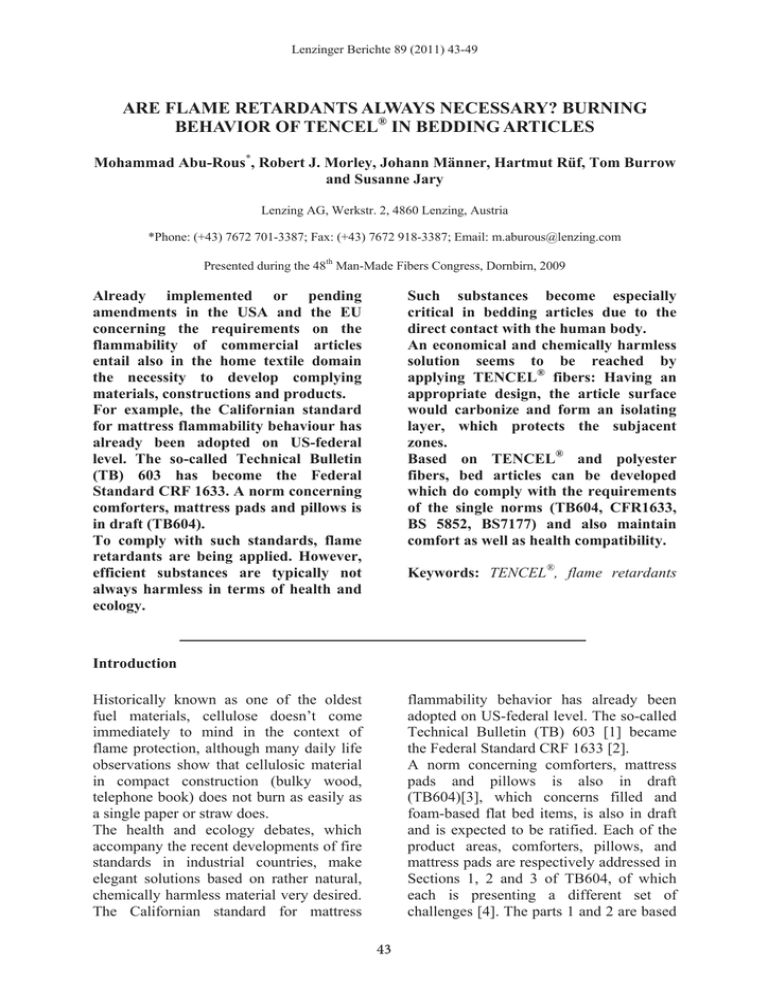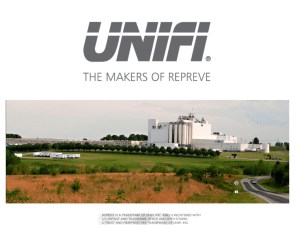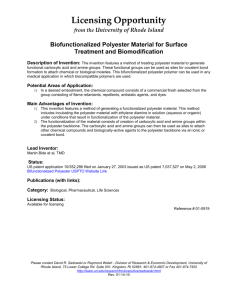are flame retardants always necessary? burning
advertisement

Lenzinger Berichte 89 (2011) 43-49 ARE FLAME RETARDANTS ALWAYS NECESSARY? BURNING BEHAVIOR OF TENCEL® IN BEDDING ARTICLES Mohammad Abu-Rous*, Robert J. Morley, Johann Männer, Hartmut Rüf, Tom Burrow and Susanne Jary Lenzing AG, Werkstr. 2, 4860 Lenzing, Austria *Phone: (+43) 7672 701-3387; Fax: (+43) 7672 918-3387; Email: m.aburous@lenzing.com Presented during the 48th Man-Made Fibers Congress, Dornbirn, 2009 Already implemented or pending amendments in the USA and the EU concerning the requirements on the flammability of commercial articles entail also in the home textile domain the necessity to develop complying materials, constructions and products. For example, the Californian standard for mattress flammability behaviour has already been adopted on US-federal level. The so-called Technical Bulletin (TB) 603 has become the Federal Standard CRF 1633. A norm concerning comforters, mattress pads and pillows is in draft (TB604). To comply with such standards, flame retardants are being applied. However, efficient substances are typically not always harmless in terms of health and ecology. Such substances become especially critical in bedding articles due to the direct contact with the human body. An economical and chemically harmless solution seems to be reached by applying TENCEL® fibers: Having an appropriate design, the article surface would carbonize and form an isolating layer, which protects the subjacent zones. Based on TENCEL® and polyester fibers, bed articles can be developed which do comply with the requirements of the single norms (TB604, CFR1633, BS 5852, BS7177) and also maintain comfort as well as health compatibility. Keywords: TENCEL®, flame retardants Introduction Historically known as one of the oldest fuel materials, cellulose doesnt come immediately to mind in the context of flame protection, although many daily life observations show that cellulosic material in compact construction (bulky wood, telephone book) does not burn as easily as a single paper or straw does. The health and ecology debates, which accompany the recent developments of fire standards in industrial countries, make elegant solutions based on rather natural, chemically harmless material very desired. The Californian standard for mattress flammability behavior has already been adopted on US-federal level. The so-called Technical Bulletin (TB) 603 [1] became the Federal Standard CRF 1633 [2]. A norm concerning comforters, mattress pads and pillows is also in draft (TB604)[3], which concerns filled and foam-based flat bed items, is also in draft and is expected to be ratified. Each of the product areas, comforters, pillows, and mattress pads are respectively addressed in Sections 1, 2 and 3 of TB604, of which each is presenting a different set of challenges [4]. The parts 1 and 2 are based Lenzinger Berichte 89 (2011) 43-49 on weight loss whilst burning and apply for bed items with loose (i.e. pillows) or ordered (i.e. comforters) fills. Part 3 is based on the fire penetration and applies for mattress pads and bed items thinner than 5 cm. This work focuses on sections 1 and 3 of TB604, where the fiber aggregation is similar. Section 2 concerns items where the fibers are mostly in loose form, and is therefore worth a separate study. The new standards require developments of complying materials, constructions and products. Initiatives of concerned US citizens are already campaigning against TB604. The expected increase of flame retardant (FR) additives brings worries in both health and ecological aspects [5, 6]. In Europe, the obligatory flammability standards make the British market special [7] and limit the options for possible materials. The British Standard 5852 was developed to assess the flammability of upholstered furniture systems by smoldering cigarettes, lighted matches and stronger ignition sources. Mattresses are regulated by the related BS 7177 [8]. It applies for mattresses, divans and bed bases Items (except comforters) sold for residential use are identified as low hazard use and must meet both a smoldering cigarette ignition test as well as a match flame equivalent ignition test. It is unknown at this time whether the European Community will adopt the British standards. However, European standards, such as EN597 [9] are barriers to be passed in order to enter the public and hospitality segments. The flammability standards are based on different observations on the burning behaviors (Table 1). Burning duration, extending speed, burning energy, weight loss, shape maintenance etc. are all criteria which are related to the burning process, but are not related to the same rate to each other. Earlier studies already recommended the use of cellulosic fibers as a solution to comply with the flammability norms [10]. Having an appropriate design, the cellulosic surface would carbonize and form an isolating layer, which protects the subjacent zones. An economical and chemically harmless solution seems to be approached by applying the cellulosic TENCEL® FILL fiber and its blends with standard polyester. The 6.7 dtex fiber can easily be blended with polyester. The aim of this study is to prove the compliance of common TENCEL® FILL/polyester blends without chemical additives with the flammability standards. Materials All TENCEL® FILL fibers are standard Lenzing fibers (6.7 resp. 1.7 dtex; 60 mm, siliconized). The polyester fiber, M1119; 5.4 dtex, 55 mm, non-siliconized, was kindly supplied by Wellman Inc (Ireland). Cotton/Polyester fabric (110 gsm) for TB604 was acquired from Lauffenmühle (Austria). FR-polyester fabric (220 gsm) for BS5852/2 and BS7177 testing was kindly supplied by Fogarty Ltd. (UK). Table 1. Overview on the test parameter and the scope of the investigated flammability standards. Standard Main criterion TB604/1 Weight loss/time TB604/2 Weight loss/time TB604/3 Flame penetration CFR1633 Burning heat BS7177 / BS5852 Burning time, flame penetration Concern Comforter, flat bed items thicker than 5 cm Pillows, loose fill Mattress pads, thin flat bed items Mattress, divans, bed bases Pillows, Mattress pads Sample form Card, fleece Fiber balls Card, fleece Complete mattress Stuffed as intended in use Lenzinger Berichte 89 (2011) 43-49 Experimental Technical Bulletin TB604 TB604/1 A 38x38 cm cushion made of the cotton/polyester fabric defined by the standard was prepared and stacked with multiple layers of the fiber sample to reach a thickness of approximately 89 mm under a Plexiglas plate defined by the standard. The sewn cushion was conditioned for at least 24 hours at 20°C and 50% rh. The cushion was exposed to a defined fire flame for 20 seconds, and the weight loss during the burning process was measured (Figure 1). The surface of the test specimen was exposed to a 35 mm high gas flame oriented at 30 degree with respect to the horizontal line for 20 seconds (Figure 2). After removing the flame, the burning process was observed. After all traces of flaming and smoldering have ceased, the dimensions of largest voids in the filling material and (if existing) the two bottom fabrics were measured. BS5852/2, BS7177 Fiber sample was filled in the back and the bottom of a Chair with defined dimensions, and covered with a FR polyester shell fabric (220 gsm). The lower part of the chair back was exposed for 40 seconds to a 14 cm butane gas flame (Figure 3). Figure 1. Trial setting according to TB604/1. Figure 3. Trial setting according to BS5852/2. Figure 2. Trial setting according to TB604/3. TB604/3 A 305 mm x 305 mm fiber sample fleece was tested between two cotton/polyester standard fabric double sheets. The height of the sample was set to 50 mm under the defined Plexiglas plate. A square metal frame defined in the standards was placed over the top sheeting fabric. After removing the flame source, the sample shouldnt burn for more than 120 seconds. A further failing criterion is if it burns through or until the edge of the sample, or if burning parts fall on the sitting part of the chair. Results and discussion Results on Californian Technical Bulletin TB604 TB604/1 Figure 4 shows the time/weigh plot at the first six minutes of the sample burning. Both commercially available, TENCEL® Lenzinger Berichte 89 (2011) 43-49 Figure 4. Time/weight plot of the burning of TENCEL® FILL in comparison to regular and FR-treated polyester, tested according to TB604/1. Figure 5. Time/weight plot of the burning of TENCEL® FILL fiber and fiber blends with polyester according to TB604. fibers (1.7 and 6.7 dtex) and their 50:50 blends with polyester were able to pass, while the samples of 100% standard and FR polyester failed. Figure 6 shows the sample situation after complete burning. Independent of the residual weight, a 100% polyester sample would melt down and completely loose shape, while a TENCEL® sample, in 100% or blended, would only burn on the surface, keeping the sample interior intact. Lenzinger Berichte 89 (2011) 43-49 Figure 6. Completely burned TENCEL® FILL (left) and polyester (right) samples, according to TB604/1. Figure 7 shows different blends of TENCEL® FILL with polyester. With the right fleece construction, samples containing 30% TENCEL® FILL were able to pass. It is important to consider the fleece construction, which is decisive for the outcome of the test. TB604/3 Part three of TB604 concerns flat bed items thinner than 5 cm, such as mattress pads. This part of the standard is considered to be the most challenging due to its thinness and cost constraints [4]. The test is based on the hole which occurs in the sample after a 20 second exposure to a high gas flame. A sample would fail if a hole larger than 5 cm in any direction results from the completed burning process. In this test setting, even FR polyester samples failed after melting down and burning to a plastic mass. Oppositely, cellulose samples showed only a superficial burning and the carbonized surface hindered the oxygen from reaching the sample inside. The interesting point here is also the fact, that TENCEL®/Polyester blends performed similarly to 100% TENCEL®. Figure 8 also shows the behavior padding applications, which are thinner than 5 cm. TENCEL® FILL passes even in a 50:50 blend with regular polyester. Figure 7. A TENCEL® FILL/polyester fiber blend (left), compared to 100% polyester, burned according to TB604/3. Figure 8. 2.5cm high thick samples of 100% TENCEL® FILL and a 50:50 TENCEL® FILL/polyester blend (left), burned according to TB604/3. Figure 9. A 100% polyester sample burned according to TB604/3 using a protective barrier fabric. Lenzinger Berichte 89 (2011) 43-49 Additionally, it was observed that a flame retardant barrier fabric is not always enough to make a standard polyester mattress pad pass TB604/3. The melting beneath the fabric leads to larger holes in the pad, or in some cases to a burnthrough (Figure 9). Results on BS7177 The main pass/fail criterion is the smoldering time after a forty second exposure to a prescribed flame. None of the two trials performed on the chair should fail. A further failing criterion is burn through, or if burning parts fall on the sitting part of the chair. Figure 10 shows a sample which passed the test. Figure 11. Burning behavior of TENCEL® FILL/polyester 50:50 blend (left) in comparison to 100% wool (right). Figure 10. Test sample burned according to BS5852/2. The packing density was observed to be one of the most decisive factors in the burning performance. 100% standard polyester did not smolder for longer than two minutes, but a burn-through was observed and the samples failed hence. The same phenomenon was observed on wool (Figure 11). TENCEL® FILL and its 50:50-blend with polyester do not show such a burn-through. On the other hand, the polyester blend was critical concerning the burning time. However, the 100% TENCEL® sample, where the fibers are well paralleled, passes the test showing neither long smoldering nor burn-through. Conclusions Table 2 summarizes the compliance of TENCEL® FILL and its blends with regular polyester with both standards in question. TENCEL® fibers and their 50:50 blends with regular polyester could match the requirements of TB604 for flat bed items containing fibers in an ordered (paralleled) form. Furthermore, the fibers can comply with the British standard 7177 when used in the right construction, where surface carbonization occurs and isolates. The same phenomenon can be utilized in other filled and textile items to match other flammability standards for household and hospitality articles, such as the European cigarette and match test EN597 and similar standards. This will be the subject of a separate study. Lenzinger Berichte 89 (2011) 43-49 Table 2. Summary of the results (up-to-now) on the compliance of TENCEL® FILL and its blends with standard polyester to the standards in concern. Fiber content Fiber BS5852/2 ; BS7177 TB604/1 TB604/3 [%] Mattress pads, divans, Mattress Use domestic pillows, upholstered Comforters Pads cushions TENCEL FILL 100% X X X 6.7dtex TENCEL FILL 50% X X 6.7dtex TENCEL FILL 1.7 dtex TENCEL FILL 1.7 dtex 100% 50% Acknowledgments Johann Gruber, Heidrun Weissl and Gerold Riedl , Lenzing AG for the sample preparations and TB604 test performance, Florian Justl for help in digital processing of film material, Noel McEnroe, Wellmann for the polyester fiber, Kevin Smithbone, Fogarty, UK for the BS 7717 testing. References [1] State Of California, Department of Consumer Affairs, Technical Bulletin TB603, Requirements and test procedures for resistance of a mattress/box spring set to a large open flame, July 2003. [2] Consumer Product Safety Commission, 16 CFR Part 1633, Standard for the Flammability (Open Flame) of Mattress Sets; Final Rule, Federal Register / Vol. 71, No. 50 / Wednesday, March 15, 2006 / Rules and Regulations. [3] State of California, Department of Consumer Affairs, Technical Bulletin TB604: Test procedure and apparatus for the open flame resistance of filled bedclothing, Draft October 2007. [4] Jeff Vercellone, Kaneka Corporation, The regulation of bedclothing materials for Flame retardancy A Stakeholders X X X X X Perspective, NIST Barrier Workshop March 18, 2009. Fabric [5] Arlene Blum, Averting a California toxics disaster, Green Science Policy Institute, California Progress Report, 11.03.2009, http://www.californiaprogressreport.com/2 009/03/averting_a_cali.html [6] Green Science Policy Institute; http://greensciencepolicy.org/regulations/ [7] British Standard BS7177:1996, Specification for resistance to ignition of mattresses, divans and bed bases. [8] IN TOUCH, a regular publication of the Polyurethane Foam Association (PFA). Flammability Update: Flexible Polyurethane Foam Industry Strives to Further Reduce Fire Deaths and Injuries, http://www.pfa.org//intouch/text/v7n1.txt [9] ÖNORM, EN597, 1995: Furniture Assessment of the ignitability of mattresses and upholstered bases- Part 1 (smoldering cigarette) and 2 (match flame equivalent). [10] Mc Fadyen J. P. Wellmann Inc., Flame retardant furniture and top-of-thebed filling applications, 44th International Man-Made Fibers Conference, September 22th 2005.


